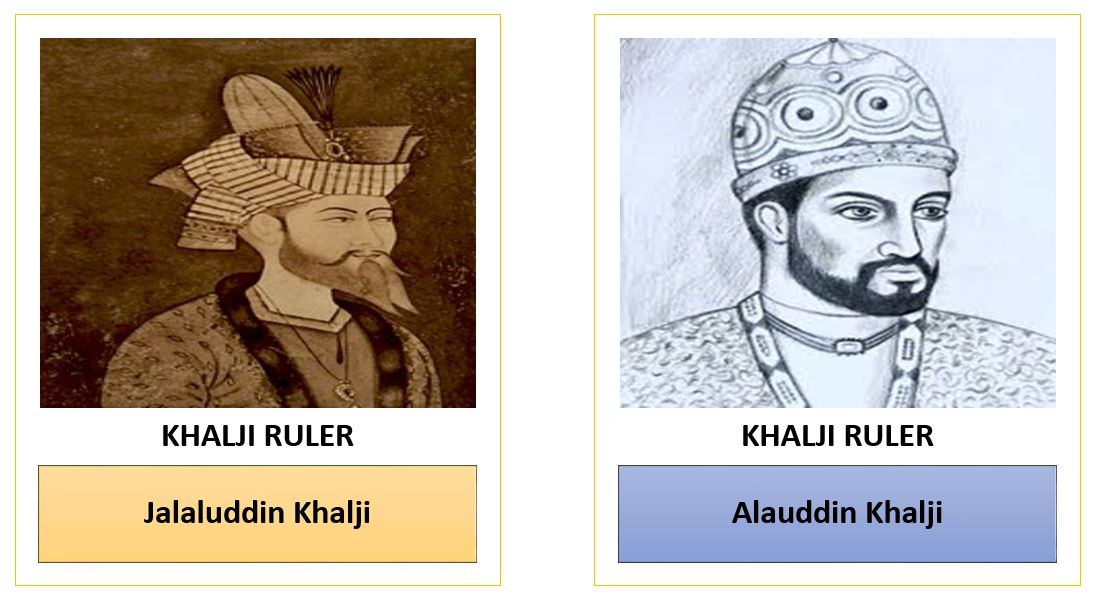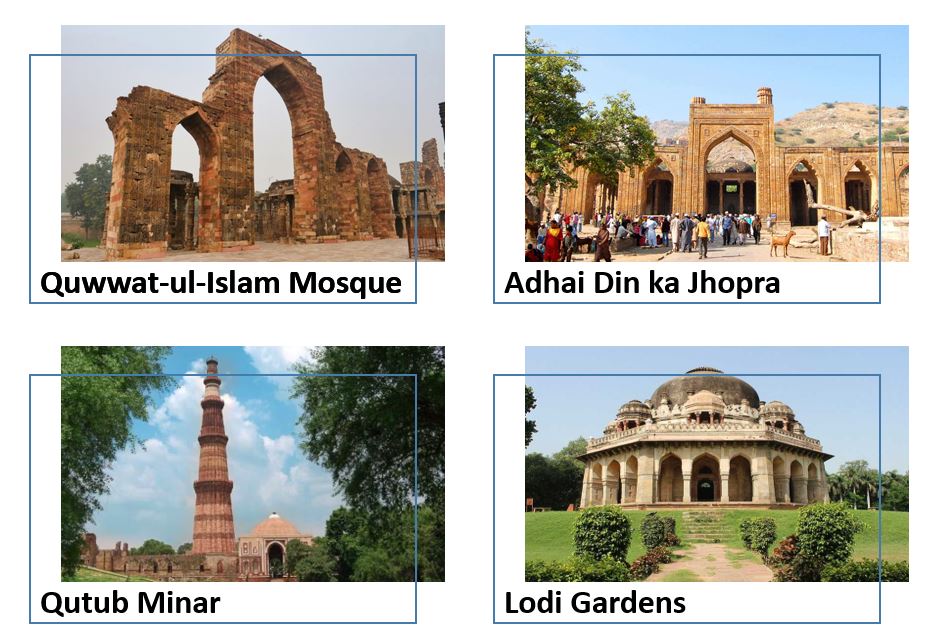Delhi Sultanate - Slave Dynasty, Khiljis, Tughlaqs, Sayyids, Lodhis | Delhi Sultanate Administration | Economic and Social Life | Art and Architecture
The rulers between 1200 AD to 1526 AD in North India were termed as Sultans and the period of their rule was the Delhi Sultanate. The rulers of the Delhi Sultanate were of Turkish and Afghan origin. They established the rule after defeating Indian ruling dynasties.
Five different dynasties ruled over Delhi between 1200 AD to 1526 AD. These rulers were of Turkish and Afghan origin. The Turkish rulers established their rule in Delhi by removing the Tomara rulers.
Muhammad Ghuri was succeeded by Qutubddin Aibak, a Turkish slave, who established the Delhi Sultanate in India. Ibrahim Lodi was the last ruler of the Delhi Sultanate. He was defeated by Babur in 1526 AD.
Dynasties of Delhi Sultanate
1. Mamluks/ Ilbari Dynasty/ Slave Dynasty (AD 1206–AD 1290)
- Mamluk Sultans or the slave dynasty started with Qutbuddin Aibak. They ruled from 1206 to 1290 AD.
A. Qutbuddin Aibak (1206 AD–1210 AD):
- Qutbuddin Aibak was the founder of the Delhi Sultanate. He was the independent Muslim ruler of Northern India.
- He was also known as “Lakh Baksh”. He was brave, faithful and generous.
- He faced many revolts from Rajputs and other Indian chiefs. He defeated Yaldauz and occupied Ghazni.
- At the Second Battle of Tarain, he was in charge of the general disposition of the Ghurid army.
- Quwwat-ul-Islam Mosque near Qutb Minar was built by Qutbuddin Aibak in 1199 AD.
- He died after falling from his horse while playing chaugan (Polo) in 1210 AD.
B. Iltutmish (1210 AD–1236 AD):
- After the death of Qutbuddin Aibak, Turkish chiefs of Delhi invited Iltutmish (son-in-law of Qutbuddin Aibak).
- Iltutmish defeated Aram Shah and ascended the throne in 1210.
- Iltutmish is considered the real founder of the Delhi Sultanate. He defeated Yaldauz in AD 1215 in the battle of Tarain.
- He avoided a confrontation with the Mongols when Chenghiz Khan destroyed the Khwarizm expired in 1210 AD.
- He established the ‘Group of Forty’ (Turkan-i-Chahalgani). It was a group of Turkish nobles who helped the Sultan in administering the Sultanate.
- He introduced two basic coins– the silver ‘Tanka’ and the copper ‘Jittal’.
- He realized the economic potentiality of the Doab and the iqtas were distributed mainly in this region.
C. Razia Sultan (1236 AD- 1240 AD)
- Iltutmish considered Razia Sultan as his successor. Raziya ascended the throne with the support of the people of Delhi and some military leaders.
- Raziya tried to form a counter-nobility of non-Turks. She appointed Malik Jamaluddin Yaqut as the amir-i-akhur (master of the horses).
- Turk's noble realized that Raziya was not willing to become a puppet of their hands.
- She got killed and her reign came to an end in 1240 AD.
D. Nasiruddin Mahmud (1246–66 AD):
- Behram Shah (1240–42 AD) and Masud Shah (1242–46 AD) were made sultans after the Raziya.
- In 1246 AD, young Nasiruddin (grandson of Iltutmish) ascended the throne.
- Ulugh Khan known as Balban assumed the position of Naib (deputy).
E. Balban (1266–87 AD):
- Balban also known as Ulugh Khan ascended the throne in 1266 AD.
- Balban breaks the power of the Chahalgani. He appointed spies in every department.
- He ruled in an autocratic manner and worked hard to elevate the position of the Sultan.
- Balban reorganised the military department (diwan-i-arz).
- He started the sijada (prostration) and paibos (kissing of the monarch’s feet) in the court.
- He refused to laugh and joke in the court and even gave up drinking wine.
- He introduced a new theory of kingship and redefined the relations between the Sultan and nobility.
- Balban adopted the policy of "Blood and Iron" to deal with the law and order situation of the reign.
- Balban died in AD 1287. After his death, the nobles raised his grandson Kaiquabad to the throne.
- It brought to an end of the slave dynasty and Firoz ascended the throne under the title of Jalaluddin Khalji.
2. Khalji Dynasty (1290–1320 AD)
A. Jalaluddin Khalji (1290–1296 AD):
- Jalaluddin Khalji is the founder of the Khalji dynasty. He ascended the throne at the age of 70.
- He started his career as an officer of the Mamluk dynasty.
- In the first year of his reign, he ruled from Kilokhri to avoid confrontations with Turkish nobles.
- He was assassinated by his nephew Alauddin Khalji in 1296 AD.
B. Alauddin Khalji (1296–1316 AD):
- Alauddin Khalji ascended the throne in 1296 by killing Jalaluddin Khalji.
- He had helped his uncle in his struggle for power and was appointed as Amir-i-Tuzuk (Master of Ceremonies).
- During the reign of Jalaluddin Khalji, he led the first Turkish expedition to southern India and plundered Devagiri.
- He made several significant administrative changes, related to revenues, price controls, and society.
- He conquered the kingdoms of Gujarat (raided in 1299 and annexed in 1304), Jaisalmer (1299), Ranthambore (1301), Chittor (1303), Malwa (1305), Siwana (1308), and Jalore (1311).
- Delhi Sultanate expanded beyond North India under the Alauddin Khalji rule.
- He adopted the title of Sikander-i-Sani.
- He introduced system of Dagh (branding of horse) and Chehra system (for soldiers).
- He was the first Turkish sultan to separate religion from politics.
- He started Turn coat policy for nobles in which he curbed the powers of the nobles and interference of Ulema in the matters of the state.
- Alauddin set up three different markets for different commodities in Delhi. These markets were the grain market (Mandi), cloth market (Sarai Adl) and the market for horses, slaves, cattle, etc.
- Shahna-i-Mandi was the officer responsible for overseeing the mandi.
- Alauddin fixed the cost of all commodities from food grains, sugar and cooking oil to horses, cattle and slaves.
- Alauddin needed a Large Army to keep a check on the attack so he kept a regulated market.
3. Tughlaq Dynasty (1320 AD–1412 AD)
- The Tughlaq dynasty was founded by Ghiyasuddin Tughlaq in AD 1320.
- Ghiyasuddin Tughlaq died in AD 1325, and his son Muhammad Tughlaq ascended the throne.
A. Muhammad Bin Tughlaq:
- He transferred the capital from Delhi to Deogir (Daultabad). It was an attempt to bring south India under the Delhi Sultanate.
- He introduced token currency and commenced a bronze coin with the same value as the silver tanka.
- He conducted several bold experiments and showed a keen interest in agriculture.
- He wanted to conquer the country of Khurasan, Transoxiana, and Iraq with the help of the Persian emperor. He spent lakhs of rupees on this mission but the Persian emperor refused to help, causing a huge financial loss and dismissal of the project.
- He launched the Qarachil expedition in Kumaon Hills in the Himalayas. It failed due to disaster.
B. Firuz Shah Tughlaq:
- He was a ruler from the Tughlaq dynasty, who reigned over the Sultanate of Delhi from 1351 to 1388.
- He faced many rebellions, including in Bengal, Gujarat, and Warangal.
- Tughlaq upheld the laws of Islam and adopted Sharia policies. He imposed a Jizya tax on all non-Muslims.
- He built a system of canals from the Yamuna to the Sutlej to support the newly founded city of Hissar-i-Firoza.
- He reintroduced a hereditary system for the nobles, including iqta.
- He set up a separate department of slaves known as 'Diwan-i-Bandagan’ and also established Diwan-i-lstibqaq to give financial support to the poor.
- Timur captured Delhi in 1398 and caused the annihilation of the Tughlaq dynasty by pillaging and slaughtering people.
4. Sayyid Dynasty (AD 1414–AD 1450)
A. Khizr Khan (1414- 1421 AD):
- In 1398, Timur appointed Khizr Khan as the ruler of Multan. Khizr Khan was the most prominent ruler of the Sayyid dynasty.
- He was the founder of the Sayyid Dynasty and assumed the throne of Delhi in 1414.
- He brought parts of Surat, Dilapur, and Punjab under his control.
- After Khizr Khan’s death, Mubarak Shah (AD 1421–34) and Muhammad Shah (AD 1434–45) took control of the throne.
B. Mubarak Shah (1421-1434 AD):
- He was the second monarch of the Sayyid dynasty. He assumed the throne in 1421.
- He subdued the rebellion at Bhatinda and Daob and the revolt by Khokhars Chief Jasrat.
- Mubarak Shah was killed in 1434 and was succeeded by his nephew, Muhammad Shah.
C. Muhammad Shah (1434-1445 AD):
- He defeated the ruler of Malwa with the help of Bahlul Lodi, the Governor of Lahore.
- In 1445, Muhammad Shah nominated his son Ala-ud-din Alam Shah, as his successor.
D. Ala-ud-din Shah (1445-1451 AD):
- He was the last ruler of the Sayyid dynasty. He assumed the name Alam Shah upon ascending the dynasty.
- On April 19, 1451, Bahlul Khan ascended to the throne of Delhi by removing Alam Shah.
5. Lodi Dynasty (1451 AD –1526 AD)
A. Bahlol Lodi:
- The Lodhi Dynasty was founded by Bahlol Lodi. The Lodis were the last ruling family to be headed by Afghans.
- He successfully suppressed the revolts in Mewat and Doab and defeated the Sultan of Jaunpur in 1476 AD.
- The tomb of Bahlol Lodhi is in Delhi. It is a square chamber with arched openings on all sides.
- After the death of Bahlol Lodi, Sikandar Lodi assumed the throne.
B. Sikandar Lodi:
- He ruled over parts of northern India from 1489 to 1517.
- He expanded the Lodi Dynasty region beyond Delhi into Gwalior and Bihar.
- He was also a poet of the Persian language and prepared a diwan of 9000 verses.
- He signed a treaty with Alauddin Hussain Shah and his kingdom of Bengal.
- After the death of Sikandar Lodi in AD 1517 his nobles helped Ibrahim Lodi to became Sultan.
C. Ibrahim Lodi:
- He was the last Sultan of the Delhi Sultanate and ascended the throne in 1517.
- He faced several rebellions and also displeased the nobility when he replaced old and senior commanders with younger ones.
- In the battle at Panipat, Babur defeated Sultan Ibrahim Lodi in AD 1526.
- Babur's forces numbered around 12,000–25,000 men, while Ibrahim had around 50,000–120,000 men.
- Daulat Khan sent an invitation to Babur at Kabul to invade India.
Delhi Sultanate Administration
- The Delhi Sultanate was centralized and headed by the Sultan. There was a council of Ministers Majlis-i-Khalwat to assist the Sultan.
- During the sultanate period, the Sultanate was divided into lqtas (regions). 'Iqtas' were divided into smaller units 'shiqqs', 'parganas' and the villages.
Iqta System
- Under the Iqta System, the army commanders and nobles were given territories to administer and collect the revenue.
- The territories assigned were called iqta and their holders as iqtadar or muqti.
- In due course, the muqti or Walis was given complete charge of the administration of the iqta which included the task of maintaining an army.
- The Khwaja was appointed to keep a record of the income of the Iqtas.
- During the time of Firuz Shah Tughlaq, iqtas became hereditary.
A. Sultan:
- He heads the civil administration and was the Supreme Commander of the Army.
- He is responsible for making all appointments and removing officials from the service.
- He also heads the Judiciary and confers titles and honours to people.
- Diwan–i–Wizarat was the most important position after the Sultan.
- The Sultan remains under pressure from a powerful group of nobility and Ulema.
B. Nobility:
- The nobles enjoyed high social status and were different groups within the nobility.
- The group of chahalgani (group of 40 nobles) was created by Iltutmish.
- The doors of the nobility were opened to people of diverse backgrounds during the rule of the Khalji and Tughlags.
- The low caste people both Hindus and Muslims, joined the nobility during the Muhammad Bin Tughlaq.
C. Ulema:
- The intellectual group of Muslims was collectively known as Ulema. They managed religious matters and interpreted religious regulations for the Sultan.
- This group used to pressure the sultan to run the Sultanate as per the religious laws of Islam.
- The Sultan and nobles generally tried to run the administrative affairs.
Departments under Delhi Sultanate Administration
| Central Department | Function |
| Diwan-i-arz | Department of Military |
| Diwan-i-Bandagan | Department of slaves |
| Diwan-i-insha | Department of correspondence |
| Diwan-i-Ishtiaq | Department of pensions |
| Diwan-i-Khairat | Department of charity |
| Diwan-i-kohi | Department of agriculture |
| Diwan-i-Mustakhraj | Department of arrears |
| Diwan-i-Qaza-i-Mamalik | Department of justice |
| Diwan-i-Risalat | Department of appeals |
Officials under the Delhi Sultanate Administration
| Title | Role/Responsibility |
| Diwan-i-Ariz | Minister of War or Chief of Army |
| Wazir | The most important office was the Diwan-i-Wizarat, headed by the wazir, who is responsible for administration and finance. |
| Diwan-i-Insha | Head of the Department of Correspondence and Petitions |
| Diwan-i-Risalat | Head of the Department of Religious Affairs |
| Diwan-i-Khairat | Head of the Department of Charity and Religious Endowments |
| Diwan-i-Mustakhraj | The officer responsible for checking and verifying revenue accounts |
| Qazi | Islamic judges are responsible for dispensing justice according to Sharia law |
| Barid-i-Mumalik | Head of the information and intelligence department. |
| Ariz-i-Mumalik | Head of the military department |
| Muqaddam | Local village headman responsible for tax collection and administration |
| Kotwal | Chief of Police responsible for maintaining law and order in cities |
| Amil | Revenue officer responsible for revenue collection in a district |
| Musharraf-i-Mumalik | Accountant General |
| Karkun | Clerk or administrative assistant |
Local Administration under Delhi Sultanate
- The village was the smallest unit of administration.
- The main village functionaries were khut, Muqaddam and Patwari.
- The important Pargana officials were Chaudhary, Amil (revenue collector) and Karkun (accountant).
- Village and Pargana were independent units of administration.
Economy during Delhi Sultanate Period
- The economy of the Sultanate period was primarily agrarian, with trade and commerce playing a crucial role.
A. Agriculture:
- Agriculture flourished during the time of the Delhi Sultanate due to the clearing of forests and exposure of fertile land, improvement in tools with the use of more iron.
- The surplus production enhanced the non-agricultural production in due course of time.
- Well was the major source of irrigation. The technique of canals flourished during Firoz Shah Tughlaq.
- Rice and Sugarcane were produced in the east and south regions. Sesame, indigo and cotton were also produced.
B. Trade and Commerce:
- Indian foreign trade was truly in the flourished stage. The trade with central and western Asia was in the hands of Multanis.
- The production of cotton increased due to the introduction of the spinning wheel.
- Bengal and Gujarat were famous for their fine-quality cotton cloth (Muslin).
- Overland trade both overseas and overland trade flourished during this time.
- Merchants were known as Karwanis and Multanis. Karwanis or Nayaks as those merchants who traded in food grains.
C. Taxation System:
There were mainly five types of taxes:
- Ushra: It was the land tax imposed on non-Muslims on the total production. It was a 10% tax on the harvests of irrigated land and 5% on Land dependent on well water.
- Kharaj: It was a type of individual tax on agricultural land and its produce was initially imposed only on non-Muslims.
- Khams: It was a tax on Mines, treasure troves, and a share of war booty.
- Jizya: It was originally imposed in India by Qutb-ud-din Aibak. It was a tax imposed on non-Muslims living under Muslim rule. It allows non-Muslims to practice their religion while living under Muslim rule.
- Zakat: It is an obligation upon Muslims to pay 2.5% of their savings to the poor and needy.
D. Crafts and Industries:
- Textile was the largest industry of the Delhi Sultanate period. The spindle came to India in the 14th century.
- The building industry was the second-largest employment sector during the Delhi Sultanate.
- The paper industry was new in the Delhi Sultanate period. The cheapest mineral of the time was salt.
Art and Architecture under Delhi Sultanate
- The architecture of the Delhi Sultanate is famous for three architectural styles- Delhi style, provincial style, and Hindu style.
- The arch and dome were new architectural additions of the period. Arches are made in a variety of shapes, but in India, the pointed form of the Islamic world was directly inherited.
- Calligraphy is an important element of the decorative art in the buildings of this period. The Quranic sayings are inscribed on buildings.
- Stone has been used abundantly in the masonry work of this period. The material commonly used for plastering buildings was gypsum.
- Monuments like the Quwwatul Islam mosque (1198), Qutab Minar (1199–1235), and Adhai Din Ka Jhonpra (1200) were built.
- The Qutub Minar is the world's tallest brick minaret at 72.5 metres, built by Qutb-ud-din Aibak of the Slave dynasty in 1192 CE.
- Adhai Din Ka Jhopra is a historical mosque in the city of Ajmer in Rajasthan. It was built by Qutb-ud-Din-Aibak in 1192 CE.
- For the first time, a true Arch was witnessed in the Tomb of Balban.
- The Alai Darwaza in the Qutub complex (1305) and the Jamat Khana Masjid at Nizamuddin (1325) are examples of the Khalji period.
- During Alauddin Khalji’s rule, Hauz Khas was built (part of Siri, city of Alauddin). The tank was de–silted during the reign of Firuz Shah Tughlaq (1351–88).
- The new architectural style of the Tughluq period is represented by the use of stone rubble as the main building material.
- Muhammad Bin Tughlaq built the fourth city of Delhi named ‘Jahanpanah’.
- Firuz Shah Tughlaq built the fifth city of Delhi, Firuzabad. He added two more storeys to Qutub Minar.
- The Tomb of Sikander Lodi in the Lodi Gardens is the first example of the Double Dome architecture.
| Monument | Period/Ruler |
| Qutub Minar | 12th century / Qutb-ud-din Aibak |
| Alai Darwaza | 12th century / Qutb-ud-din Aibak |
| Quwwat-ul-Islam Mosque | 12th century / Qutb-ud-din Aibak |
| Alai Minar | 14th century / Alauddin Khalji |
| Hauz Khas Complex | 14th century / Alauddin Khalji, Firuz Shah Tughlaq |
| Tughlaqabad Fort | 14th century / Ghiyas-ud-din Tughlaq |
| Firoz Shah Kotla | 14th century / Firuz Shah Tughlaq |
| Siri Fort | 14th century / Alauddin Khalji |
Music during Delhi Sultanate period
- Amir Khusro invented two musical instruments namely, Tabla and Sitar.
- Alauddin Khilji gave Amir Khusro a title called "Tuti e Hind" (parrot of India).
- Hindustani Music (Composite music) developed during this period.
Literature during Delhi Sultanate period
| Author | Important Works |
| Amir Khusrau | Khazain ul-Futuh, Tughlaq Nama, Laila Majnu |
| Ziauddin Barani | Tarikh-i-Firuz Shahi |
| Ibn Battuta | Rihla (The Journey) |
| Amir Hassan Sizzi. | Fawaid-ul-Fuad |
| Alberuni | Alberuni, Tahkik-i-hind |
Social Life during the Delhi Sultanate Period
- The society was divided into four major groups: nobles (Aristocrats), priests, townspeople, and peasants.
- No change can be seen in the structure of Hindu society during this period, brahmans enjoyed a respectful place in the society.
- The major population were peasants and village headmen (muqaddams) and smaller landlords (Khuts) enjoyed a high standard of life.
- The slave system was prevalent among the Muslims and the Hindus.
- A large section of the town consists of Slaves and domestic servants. Slavery is adopted by Arabs and later Turks.
- The purdah system for women become popular in this period.
- Temples can be built within the privacy of homes.
- The Muslims were also divided based on religious sect, education and professions.
Reasons for Decline of the Delhi Sultanate
- Invasion of Timur (ruler of Samarkand) during the reign of Nasiruddin Mohammed Tughlaq in 1398 AD.
- Incompetent and intolerant nature of some of the Sayyid and Lodi rulers.
- The rulers of the Vijayanagar and Bahmani Kingdom in the South were the first to break free from Delhi.
- Other regions like Assam, Bengal, Khandesh, Gujarat, Jaipur, Kashmir, Multan, Malwa, Sind, and Orissa also became independent.
- First Battle of Panipat in 1526 A.D. brought the downfall of the Delhi Sultanate in India.







 Latest
Latest 



Comments